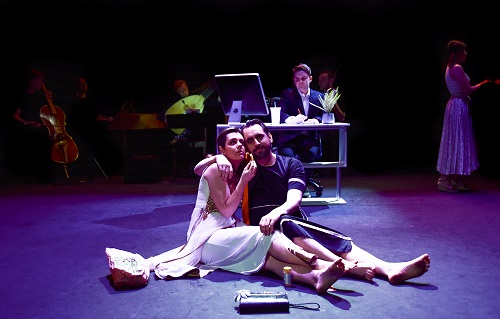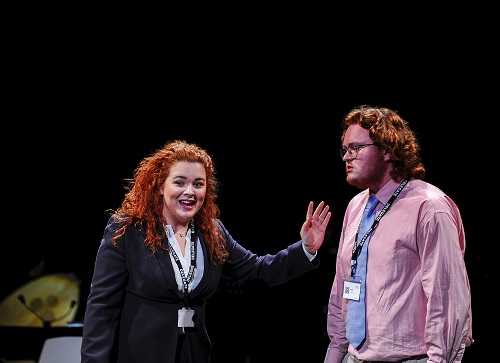 United Kingdom Blow, Purcell: Soloists, HGOAntiqua Orchestra / Seb Gillot (conductor). Cockpit Theatre, Marylebone, London, 20.5.2022. (MB)
United Kingdom Blow, Purcell: Soloists, HGOAntiqua Orchestra / Seb Gillot (conductor). Cockpit Theatre, Marylebone, London, 20.5.2022. (MB)

Blow – Venus and Adonis
Purcell – Dido and Aeneas
Production:
Director – Jessica Dalton
Choreographer – Kate Goldie Cheetham
Lighting – Tom Turner
Casts:
Venus and Adonis
Venus – Elizabeth Green
Adonis – Conall O’Neill
Cupid – Ralph Thomas Williams
Shepherdess – Hannah Savignon-Smythe
Huntsman – Matthew Secombe
Shepherds – Garreth Romain, Angelo Fallaria, Fabian Tindale Geere
Dido and Aeneas
Dido – Katey Rylands
Aeneas – Sonny Fielding
Belinda – Julia Surette
Sorceress – Helena Cooke
Second Woman – Isabelle Haile
Witches – Olivia Carrell, Abbie Ward
Spirit – Hannah Savignon-Smyth
Sailor – Matthew Secombe
Two operas from the English dawn of the genre: a winning combination, if not so frequently encountered as one might expect. Purcell’s Dido and Aeneas is, of course, universally considered a landmark in the histories both of English music and of opera: ‘Tristan and Isolde in a pint pot’, as Raymond Leppard once called it (and I have probably quoted at least once too often). Blow’s Venus and Adonis, still earlier and more closely tied to the Stuart court masque tradition, will doubtless always be less popular; it has many of its own virtues, though, which arguably emerge all the more clearly when one has such opportunity not only to compare but also to contrast.
HGO’s Venus, directed by Jessica Dalton, begins aptly enough in the office of a modern dating bureau, an obvious yet telling location for Cupid to initiate his Prologue proceedings, essentially a programme of instruction (as becomes more apparent still in the second of the three short acts). Shepherds and shepherdesses try out, consider, and swap partners — probably inconclusively. Then the action returns to more or less where it ‘should’ be: a mythological setting that is probably ancient, but really could be anywhere, suggesting a ‘universality’; that will be part, though only part, of our consideration when answering the puzzling — and puzzlingly little-asked — question as to why we are so interested in the art of the past at all, and how it comes to speak to us. Various second-act dances — perhaps more masque than opera, even by this work’s standards — are well choreographed and danced, such as might well have pleased the man who above all had to be pleased: Charles II. Often, less is more; here, something straightforward and stylish eminently fits the bill.
Questions of performance and meaning are complicated further, of course, by a performing art such as music, indeed perhaps especially so by music, more so than spoken drama, in which we can cling to the fiction — we hardly have an alternative — that our ‘instruments’ remain the same. We do so, to greater or lesser extents, when it comes to voices, but greater controversies issue with respect to other musical instruments. Today, again somewhat puzzlingly, opera appears to have decided upon a mixture of ‘period’ musical practices and more ‘contemporary’, or at least ‘modern’, theatre. This is not really the place to question that; it is a complex question, and much is a matter of business too, as well as allied pragmatics. What we see and hear is generally said to work, and we (nearly) all want something that works rather than something that does not. Such questions and others, related, are nevertheless worth reminding ourselves of, though, at least from time to time; for surely history interests when it renders strange, as well as when it renders familiar, and these things are likely to change according to what is (and is not) more common practice.

For Dido, we return to an office. I admit I had not at all gathered Dalton’s concept, prior to reading the programme. Apparently, the action takes place ‘in the halls of a modern political institution, something a little like the UN perhaps, or the EU’, and Dido is a political leader. I am afraid it all looked rather like a provincial sales office to me, perhaps having an ‘away day’. It is probably not worth retelling my misunderstanding beyond that, other than to say that the witches appear to be cleaners, understandably offended by the mess people had made, and that Dido eventually swallows some pills, no pyre in sight. I was clearly not on the right wavelength, yet in retrospect can see a degree of overall framing between the two works, the loneliness of online dating replicated in that of Dido’s suicide and the inability of others to see in time what had happened.
Musically, however, one could enjoy a parade of excellent, increasingly confident young singers, all of them worth our attention, providing a sense of company both in dramatic interaction and in their coming together (some of them) as small chorus in both operas. Elizabeth Green’s Venus and Conall O’Neill’s Adonis were both beautifully sung, with excellent attention to verbal as well as musical matters. Ralph Thomas Williams’s Cupid made for a lively and mischievous cat to set among the pigeons. Katey Rylands and Sonny Fielding offered a Dido and Aeneas who grew considerably within the small confines of Purcell’s operas, the former’s Lament deeply moving in the best of traditions, the latter’s dark tone nicely suggestive of wounded masculinity. Again, verbal and musical acuity were finely matched. A fine ‘supporting’ cast had no weak links; I shall mention Isabelle Haile and Matthew Secombe as singers who especially caught my ear.
Using his own, specially prepared editions, Seb Gillot led a small ‘period’ band in performances that loved to dance, but also to engage in dramatically generative gradations of recitative, aria, and much that lies between (whether in more Italianate, French, or English styles), as well as in affective tonality (perhaps especially strong in Dido). In Dido, Gillot provides music for much of what has been lost, though not the mythological prologue. The additional music works well, and permits a fuller, speculative experience — as in that of, say, Benjamin Britten’s edition — of what might have been. There is imagination If I was initially surprised to hear an oboe in the Overture, my ears adjusted: so much so that there was at least one moment later on when I could have sworn I heard a wind instrument, only to look and see that a viola had tricked me. There is probably an unflattering name for such an aural condition, but here we should take it to indicated a committed performance whose small scale did not preclude greater and amply realised ambition. The darker harmonies of Dido were certainly present, portraying Venus intriguingly and productively as the more distant from us. Form, vividly apparent, helped accomplish this too. This may not always be the way I hear Purcell or Blow in my head, but it would be surprising if it were. I learned much from listening, which is all I can ask.
I shall be hearing — and seeing — Dido again next month in very different circumstances, as part of a double-bill with Bluebeard’s Castle, directed by Barrie Kosky. There is room for all, and I do not doubt that memories of this performance, as well as others, will frame and inform how I respond to that too. However unfashionable it may be to speak in such terms, Dido and Aeneas is an imperishable masterpiece; every encounter should be a joy. This, in its well-chosen context, was certainly that. As for my misunderstanding of the staging, I shall ascribe it to tiredness at the end of a long week.
Mark Berry